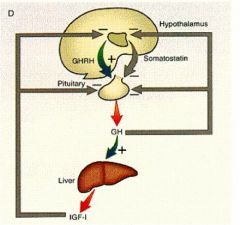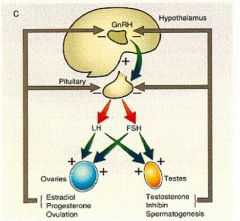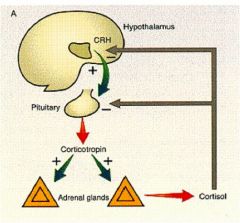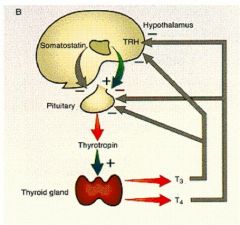![]()
![]()
![]()
Use LEFT and RIGHT arrow keys to navigate between flashcards;
Use UP and DOWN arrow keys to flip the card;
H to show hint;
A reads text to speech;
24 Cards in this Set
- Front
- Back
|
Define endocrinology.
|
Cellular communication by means of hormones.
|
|
|
Define hormone.
|
Chemical messenger released by endocrine (ductless) gland; transported in low concentrations to target cells
|
|
|
Define neurohormone.
|
Chemical messenger secreted by neurons transported via circulation to target cells.
|
|
|
What roles do receptors play in endocrinology? Where are they expressed?
|
Receptors define target cells and specific action of hormones
Expressed on cell surface (for hormones that cannot pass cell membrane) or in cytoplasm/nucleus (for hormones that can cross cell membrane; may act as transcription factors) |
|
|
Contrast the following terms:
Autocrine Endocrine Paracrine |
Autocrine: When a hormone is released into circulation and acts back on the releasing cell
Endocrine: Distal action; hormone released by cell into circulation (most common pathway) Paracrine: local action; cell releases hormone to act on neighboring cell (least common pathway) |
|
|
Contrast negative feedback with positive feedback.
|
Negative feedback: most common control of hormone secretion; hormone directly or indirectly inhibits further secretion
Positive feedback: uncommon mechanism of hormone secretion control; usually indirectly stimulates further secretion |
|
|
Starting with the hypothalamus and ending with target tissues, describe the feedback loops for Thyroid Releasing Hormone.
|
Hypothalamus releases TRH
Pituitary releases TSH Thyroid releases T4 T4 circulates to target tissues and feeds back to the hypothalamus (negative feedback) |
|
|
How is the effect of a hormone mediated if it cannot cross a cell membrane?
|
Binds a cell surface receptor and employs second messenger signaling
|
|
|
What are the benefits of having a protein-bound hormone?
|
Provides reservoir and extends half-life for hormone action
(Proteins are transporters) |
|
|
Are bound-proteins able to bind receptors or function in feedback regulation?
|
No, only free proteins can bind receptors or provide feedback
|
|
|
What's an example of a non-specific hormone binding protein?
|
Albumin
|
|
|
What do Free and Total concentrations refer to?
|
Free = concentration of unbound hormone
Total = concentration fo unbound and bound hormone |
|
|
Describe the signaling required for release of growth hormone.
|
|
|
|
What's an example of a non-specific hormone binding protein?
|
Albumin
|
|
|
What do Free and Total concentrations refer to?
|
Free = concentration of unbound hormone
Total = concentration fo unbound and bound hormone |
|
|
Describe the signaling required for release of growth hormone.
|

|
|
|
Describe the signaling required for release of growth hormone.
|

|
|
|
Describe the signaling required for release of LH and FSH.
|

|
|
|
Describe the signaling required for release of corticotropin.
|

|
|
|
Describe the signaling required for release of thyrotropin (TSH).
|

|
|
|
How does food effect insulin release?
|
Food high in sugar stimulates insulin release
Lack of food inhibits insulin release |
|
|
Describe the endocrine controls of calcium levels in the body.
|

|
|
|
What is the difference between a primary and secondary endocrine deficiency?
|
Primary: dysfunction originating in the peripheral endocrine gland itself
Secondary: understimulation or overstimulation by the pituitary |
|
|
How might endocrine resistance disorders arise?
|
Problems in receptors or second messengers
|

